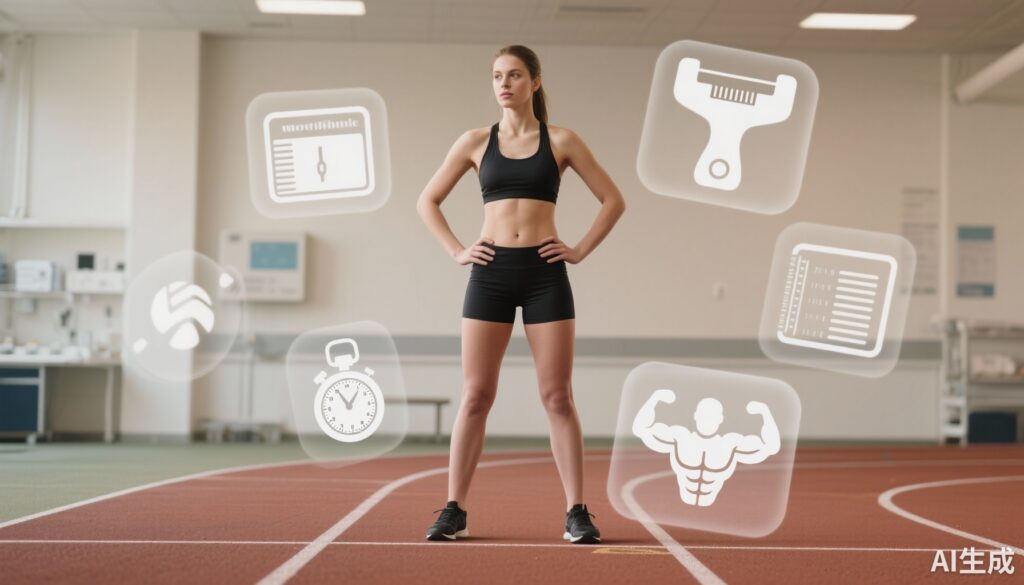Highlights
Higher body mass and BMI have small but consistent associations with several lower‑extremity injuries in female athletes (very low certainty evidence). Meta‑analyses across female‑specific estimates found no clear association for lower‑extremity strength measures or artificial turf exposure. The literature is heterogeneous: 195 studies evaluated 66 modifiable risk factor (MRF) categories across eight injury outcomes, yet 37.4% of studies had high risk of bias and most evidence is exploratory.
Background: burden and clinical context
Lower‑extremity injuries are common in sport and have immediate and long‑term consequences for athletes’ performance, participation, and musculoskeletal health. Female athletes exhibit different injury patterns and risks compared with male athletes for some conditions (for example, anterior cruciate ligament [ACL] injuries), prompting calls for sex‑ and gender‑specific research. Identifying modifiable risk factors (MRFs) — attributes or exposures that can be altered through intervention — is central to designing targeted prevention strategies and informing clinical screening and training recommendations.
The Female, Woman and Girl Athlete Injury Prevention (FAIR) consortium produced a comprehensive systematic review and meta‑analysis to synthesise evidence about potentially modifiable risk factors for sport‑related lower‑extremity injuries among females.
Study design and methods
The FAIR systematic review (Whittaker et al., Br J Sports Med. 2025) searched MEDLINE, CINAHL, APA PsycINFO, Cochrane databases, CENTRAL, SPORTDiscus, EMBASE and ERIC in late 2023. Eligible primary studies included a comparison group and reported associations between one or more MRFs and sport‑related lower‑extremity injury outcomes with at least one female/woman/girl per study group. Outcomes covered eight injury regions: general lower‑extremity, groin, hip, thigh, knee, lower‑leg, ankle, and foot.
Overall the review included 195 studies comprising 1,525,662 participants. Despite the very large pooled sample, only 2.4% of the pooled participants were female, although 58.9% of the injury estimates produced were female/woman/girl specific. The review identified 66 unique MRF categories and performed female‑specific meta‑analyses for 10 factors (e.g., body mass, body mass index [BMI], weekly training distance, muscle strength measures, artificial turf exposure, off‑season plyometric training, readiness to return‑to‑sport, single‑leg hop asymmetry, vertical drop jump peak knee flexion angle, and ground reaction force), and semiquantitative analyses for 26 additional MRFs. Risk of bias and evidence certainty were assessed using GRADE.
Key findings
Scope and quality of the evidence
– Heterogeneity was substantial across MRFs, injury definitions, study designs, and measurement methods.
– Thirty‑seven point four percent of included studies were judged to have high risk of bias. Many studies were observational and exploratory rather than hypothesis‑testing, used heterogeneous outcome definitions, and differed in exposure measurement and adjustment for confounders.
Meta‑analytic results for female/woman/girl‑specific estimates
– Body mass and BMI: Higher body mass (standardised mean difference g = 0.19, 95% CI 0.00 to 0.38; I2 = 71.7%) and higher BMI (g = 0.22, 95% CI 0.09 to 0.36; I2 = 37.0%) were associated with several lower‑extremity injuries. These effect sizes are small and the evidence was graded very low certainty.
– Lower‑extremity muscle strength: The pooled association for strength outcomes and lower‑extremity injury was essentially null (g = 0.01, 95% CI −0.11 to 0.14; I2 = 37.3%). Evidence certainty was very low, and measurement heterogeneity (different strength tests, protocols, and units) likely limits interpretation.
– Artificial turf exposure: No association was observed between artificial turf and various lower‑extremity injuries (incidence rate ratio = 0.97, 95% CI 0.88 to 1.07; I2 = 2.4%). Certainty was low.
– Other MRFs: The review conducted semiquantitative analyses for 26 additional MRFs (including training load metrics, neuromuscular control markers such as single‑leg hop asymmetry, kinematic variables like vertical drop jump peak knee flexion, readiness to return‑to‑sport measures, and plyometric training exposure). Results varied by injury outcome and were generally inconsistent or lacked robust pooled estimates; many were graded low or very low certainty.
Interpretation of effect sizes and certainty
– The small positive associations for body mass/BMI suggest a relationship that is biologically plausible (increased mechanical load, altered biomechanics), but the effect magnitudes are modest and evidence is of very low certainty because of study limitations and heterogeneity.
– Null pooled findings for strength and turf should not be interpreted as definitive evidence of no effect; measurement heterogeneity, small numbers of female‑specific studies, and residual confounding limit firm conclusions.
Expert commentary: what clinicians and researchers should take away
Clinical implications
– Screening and individualized risk assessment: The review supports consideration of body mass and BMI as part of a multifactorial risk assessment in female athletes, acknowledging that these factors alone are weak predictors. Clinicians should integrate body composition and functional testing with training history, prior injury, and sport‑specific demands when advising athletes.
– Exercise‑based prevention: The lack of a clear pooled association between isolated strength measures and injury risk does not invalidate neuromuscular training or conditioning. Rather, it highlights that single isolated metrics (e.g., maximal isometric strength) may be poor proxies for the dynamic, multiplanar demands of sport. Multi‑component neuromuscular programmes that target strength, power, landing mechanics, and movement quality remain plausible prevention strategies, but sex‑specific evidence and study designs are needed.
– Playing surface: The finding of no overall increased injury incidence on artificial turf in female‑specific estimates is reassuring, but surface type should still be considered alongside footwear, sport, and environmental conditions.
Research implications and priorities
– Female‑centric prospective studies: Despite the large number of included studies, only a minority provided substantial female participant data. Future prospective cohort studies and RCTs should be designed and powered specifically for female athletes and report sex‑stratified results.
– Standardisation of exposure and outcome definitions: Heterogeneity in MRF measurement (different strength tests, inconsistent training load metrics) and injury definitions hampers synthesis. Consensus on standard measures, testing protocols, and injury classification tailored to female athletes would improve comparability.
– Mechanistic end‑points and mediation analysis: Studying how modifiable factors (for example, body mass, neuromuscular control, fatigue) influence biomechanical and physiological pathways to injury will help identify intervention targets and dose–response relationships.
– Intervention trials targeting MRFs: Observational associations must be translated into randomized or well‑designed quasi‑experimental studies assessing whether modifying a candidate risk factor reduces injury incidence in female athletes.
Limitations of the FAIR review to consider
– Residual confounding and observational design limit causal inference.
– Aggregate proportion of female participants in pooled samples was low, even if many estimates were female‑specific; this complex sampling may influence generalisability.
– Many MRF categories were examined only in a small number of studies, reducing power for pooled analyses.
Practical recommendations for practitioners
– Use a multifactorial screening approach that incorporates body mass/BMI, movement quality, previous injury history, training load, and sport‑specific demands rather than relying on any single metric.
– Prioritise evidence‑based, multi‑component prevention programs (strength, plyometrics, landing and cutting technique, balance) adapted to the athlete’s sport, developmental stage, and practical constraints; monitor outcomes and adherence.
– Encourage data collection and sex‑stratified reporting in clinical and field settings to contribute to higher‑quality female‑specific evidence.
Conclusion
The FAIR systematic review provides the most comprehensive synthesis to date of modifiable risk factors for lower‑extremity injury in female athletes. It highlights a very large and heterogeneous literature but finds only limited, low‑certainty evidence that higher body mass and BMI are associated with increased injury risk. For many candidate modifiable factors — including strength measures and playing surface — pooled female‑specific evidence does not demonstrate clear associations, but methodological limitations and heterogeneity constrain interpretation. The review underscores the urgent need for well‑designed, female‑focused prospective studies and intervention trials, standardised measurement, and improved reporting to move from exploratory associations toward actionable prevention strategies.
Funding and registration
This synthesis is based on the FAIR systematic review as reported in Whittaker JL et al. (Br J Sports Med. 2025). The FAIR review was prospectively registered with PROSPERO (CRD42024486715). Funding sources reported by the original review authors are detailed in the source publication.
References
Whittaker JL, Räisänen AM, Martin C, Galarneau JM, Martin M, Losciale JM, Bullock GS, Dubé MO, Bizzini M, Bourne MN, Dijkstra HP, Girdwood M, Hayden KA, Hägglund M, McLeod S, Mkumbuzi NS, Mosler AB, Murphy MC, Myklebust G, Møller M, Ocarino JM, Owoeye OBA, Palmer D, Pasanen K, Rio EK, Thorborg K, van Middelkoop M, Verhagen E, Warden SJ, Whalan M, Crossley KM, Emery CA. Modifiable risk factors for lower‑extremity injury: a systematic review and meta‑analysis for the Female, Woman and Girl Athlete Injury Prevention (FAIR) consensus. Br J Sports Med. 2025 Sep 4: bjsports‑2025‑109902. doi: 10.1136/bjsports‑2025‑109902. Epub ahead of print. PMID: 40908104.



